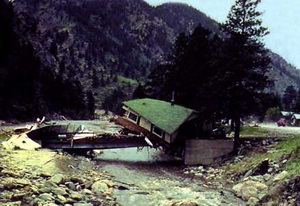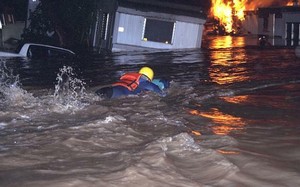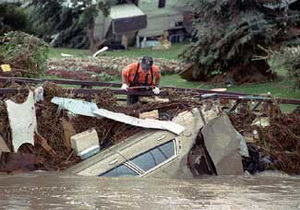
For much of Colorado, floods and flash floods present a grave danger to life and property. These usually are the result of one of two things – spring snow melt occurring rapidly or a severe thunderstorm. Colorado is very susceptible to flash flooding and these occur somewhere every year in the state.
The waters from flash floods can move with extraordinary speed and strike with little or not warning. Their force can be extremely destructive and when coupled with trees, dirt, rocks and other debris they carry downstream, they are deadly.
Flooding is the number one weather killer in the United States.
Historically, by far what was probably Colorado’s greatest weather disaster was the result of a flash flood – the Big Thompson Flood on July 31, 1976. As Colorado was celebrating its centennial, a “perfect storm” was setting up to wreak havoc west of Loveland. A thunderstorm with amazing amounts of precipitation virtually parked over the area as nearly 12 inches of rain fell in the evening in areas like Glen Haven and Glen Comfort. The Big Thompson River swelled and a wall of water and mud rushed down the canyon destroying 418 homes, causing $40 million in damage and killing 144 people. Click here to see a presentation on the Big Thompson Flood.

In recent history, on July 28, 1997 areas around Fort Collins received in excess of 14 inches of rain – the most ever recorded over an urban area in Colorado. The result was six dead and hundreds of millions of dollars in damage. The danger is present and Coloradoans need to be aware. According to Eve Gruntfest of the University of Colorado, an expert in flash floods, there are areas in the state particularly prone to dangerous flash flooding. Of greatest concern, Boulder, Manitou Springs, Colorado Springs and Black Hawk.
Flash floods get their name because they can move at incredible speeds and with little or no warning. They can cause great amounts of destruction due to not only the force of the water itself, but also by debris that is carried by the flood. Roadways, bridges, buildings and vehicles can be destroyed.
From the National Weather Service, the parameters for flood related watches and warnings are:
A Flash Flood or Flood Watch – Flash flooding or flooding is possible within the watch area. You should remain alert and be ready to evacuate within a short time.
A Flood Warning – Flooding is imminent or has been reported along a river. When a flood warning is issued take precautions to protect property.
A Flash Flood Warning – Flash flooding has been reported or is imminent. When a flash flood warning is issued for your area act quickly. If advised to evacuate, do so immediately. Go to higher ground or climb to safety before access is cut off by flood waters.

Flood Safety
- Do not camp or park your vehicle along creeks and washes, especially during threatening conditions.
- If flooding occurs, get to higher ground immediately. Get out of areas subject to flooding. This includes dips, low spots, canyons, washes etc.
- If you are near a river be aware of water levels and be prepared to go to higher ground if river levels rise.
- Do not enter areas that are already flooded.
- Do not try to cross a flowing creek on foot when the water is at or above your knees.
- If walking or fishing along a river be aware that erosion from swift flowing water can cause river banks to collapse.
- Never allow children to play around high water, storm drains, viaducts or arroyos.
- Be especially cautious at night when it is harder to see flood dangers.
![]() Over half of all flood-related drownings occur because of vehicles driving into flood waters. The next highest percentage of flood-related deaths is due to walking into or near flood waters. The main reason is people underestimate and don’t understand the force and power of water. Many of these drowning are preventable, but too many people continue to drive around the barriers that warn you the road is flooded. Six inches of water can knock over an adult. Less than two feet of water can carry away a vehicle.
Over half of all flood-related drownings occur because of vehicles driving into flood waters. The next highest percentage of flood-related deaths is due to walking into or near flood waters. The main reason is people underestimate and don’t understand the force and power of water. Many of these drowning are preventable, but too many people continue to drive around the barriers that warn you the road is flooded. Six inches of water can knock over an adult. Less than two feet of water can carry away a vehicle.
Remember TADD – Turn Around, Don’t Drown. Do not ever enter a flooded roadway, no matter how deep the water looks.
National Weather Service Statement for Severe Weather Awareness Week
PUBLIC INFORMATION STATEMENT
NATIONAL WEATHER SERVICE BOULDER CO
600 AM MDT WED APR 13 2022
Major flooding in September 2013 resulted from over eight inches of rain that fell over a large area from northern Jefferson County to the Wyoming border. This rain occurred in a number of creeks and rivers, causing considerable flash flooding. Runoff from area streams combined to cause major flooding along the South Platte River. Mitigation is still ongoing to repair flood damage along the creeks and rivers in and near the foothills from Larimer County to El Paso County and along the tributaries to the South Platte River.
Flash flooding refers to a dangerous sudden rise in water along a creek, river, or a normal dry land area. Flash floods result from heavy rainfall, sudden breaks in river ice jams, and dam or levee failures.
Flash floods can occur within a few minutes or hours, and can move at surprisingly high speeds, striking with little warning. Flash floods are quite destructive because of the force of the moving water, and the debris that accumulates in flood waters, such as trees and boulders, which can destroy roadways, bridges, and buildings.
Other complications in Colorado are recent wildfires which raise the flood threat when locally heavy rain falls on recent burn scars. Residents in and near burned areas should plan ahead on response actions for flooding.
The National Weather Service will discuss flood and flash flood potential in daily hazardous weather outlooks and in the weather story on National Weather Service websites. On days with a high threat of flooding you may hear…
A flash flood or flood watch…which means that flash flooding or flooding is possible within the watch area.
A flood warning…which means that flooding is imminent or has been reported along a river.
A flash flood warning…which means that flash flooding has been reported or is imminent. When a flash flood warning is issued for your area, act quickly. If advised to evacuate, do so immediately. Go to higher ground or climb to safety before access is cut off by flood waters.
An urban flood advisory will be issued for impact flooding that is not in itself life-threatening. In an urban area if you were commuting during rush hour during a flood advisory you could expect some intersections to be underwater and a much longer commute. A small stream flood advisory might be issued when the flow is at bankfull with minor lowland flooding along the stream.
Nearly half of all flash flood fatalities are vehicle related. Do not enter a flooded roadway, instead Turn Around, Don’t Drown. In rapidly rising waters, backing up away from water may be safer. One or two feet of water will carry away most vehicles, and you also cannot tell if the road is damaged beneath moving water.
Colorado Severe Weather Awareness Week continues through this Saturday.
This is part four of a five part series on Colorado’s severe weather.

i think this site is perty cool! i mean theinformaiotn is very useful and i thank the makers ofit. thank you makers! keep writing!